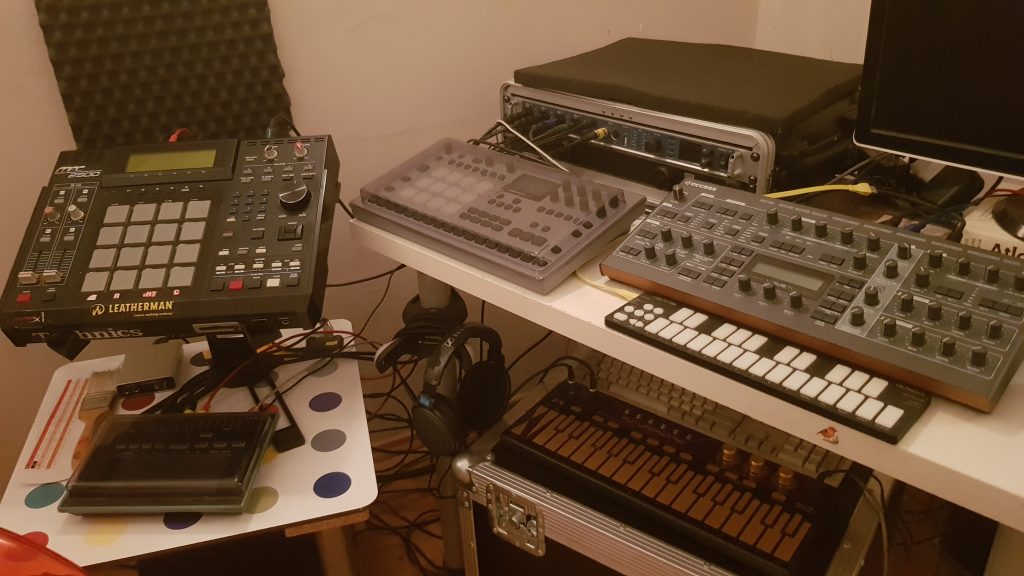playing live (update)
The Way it Was
Looking back at a year and a half ago, there have been some changes to the live setup. I replaced my aging Airbase with a proper drum computer, the Elektron Analog RYTM MkII, and I’ve sampled most of the parts I needed from it, so it is retired from live work. I’ve also retired the Waldorf Blofeld from the club setup, although it is still being used for the always-evolving street act.
Additionally, I stopped using the Lexicon MX400 (which was only used for the Airbase), the MOTU Micro Express, and the Behringer BCR2000. Now I have only the PSU and audio interface in a 2U rack case, a handheld case for the MPC, and the three synths & laptop which I put into a duffle bag. Here’s what the studio looks like today. The live setup would be the same except I would leave the keyboards at home and use the pads for live and would use the laptop instead of the PC.
In the future I hope to replace the aging MPC with a Cirklon, further reducing my weight and footprint, although its sampling functionality will probably need to be replaced with something as the RYTM has limited sampling capability, but otherwise, there’s not much changing happening. I am stuck with these machines until I completely exhaust all their ideas or I can afford to hire someone to carry my gear around.
A solid Setup
I have used the same setup for the past six months or so now using the RME UFX as the hub and using its snapshots to instantly recall mixes. The UFX has 14 inputs (discounting ADAT), so I have routed the RYTM, TB3, and Virus basically “permanently” to 12 of its 14 inputs, sending it eight channels of RTYM via cable snake, a stereo digital input from the Virus, and a stereo analog front panel input for the the TB-3, after discovering the possibilities of the FX section which showed the importance of routing the TB-3 in stereo. That leaves two front panel inputs which are now being used for vocal samples from the MPC and an extra output from the Virus, but which can be used for anything. And I’ll never need to change the I/O routing except for these front two inputs, so if I want to use a microphone in the future or add some different instrument, there are still 2 inputs which can be routed freely. Maximum stability and flexibility — the goals all along.
Moving Forward
This is the culmination of my attempt to achieve a simple but versatile, portable setup that offers stability and control without losing creativity. There are enough sonic options among these three synthesizers that I will never get bored or not be able to do something. All three synths have effects per voice, and by routing the most used drums separately, I can create better separation and clarity in my mixes by accessing fully separate per-channel effects and dynamics from RME’s Totalmix. Now begins the journey into sound where I continue exploring every facet of the instruments and allow my ideas to run free. Mixes are an important part of songs, and getting good consistent mixes from session to session in a live setting is hard to achieve, but now it seems possible. So whether it’s drum & bass, techno, electro, tech house, or whatever, the tracks are ready to play live. And that’s the whole point of this thing: to play live.

